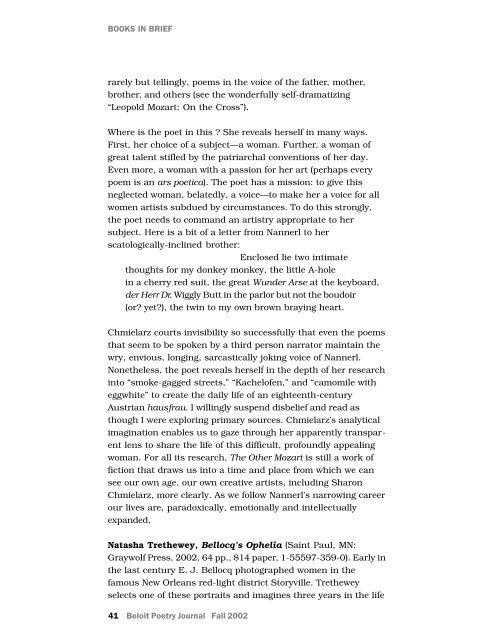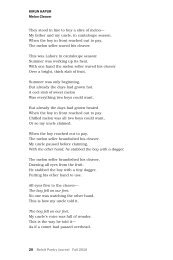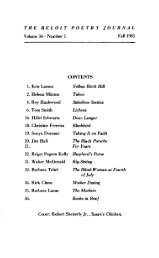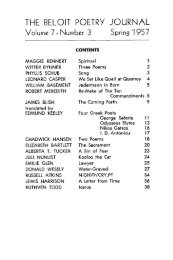You also want an ePaper? Increase the reach of your titles
YUMPU automatically turns print PDFs into web optimized ePapers that Google loves.
BOOKS IN BRIEF<br />
rarely but tellingly, poems in the voice of the father, mother,<br />
brother, and others (see the wonderfully self-dramatizing<br />
“Leopold Mozart: On the Cross”).<br />
Where is the poet in this ? She reveals herself in many ways.<br />
First, her choice of a subject—a woman. Further, a woman of<br />
great talent stifled by the patriarchal conventions of her day.<br />
Even more, a woman with a passion for her art (perhaps every<br />
poem is an ars poetica). The poet has a mission: to give this<br />
neglected woman, belatedly, a voice—to make her a voice for all<br />
women artists subdued by circumstances. To do this strongly,<br />
the poet needs to command an artistry appropriate to her<br />
subject. Here is a bit of a letter from Nannerl to her<br />
scatologically-inclined brother:<br />
Enclosed lie two intimate<br />
thoughts for my donkey monkey, the little A-hole<br />
in a cherry red suit, the great Wunder Arse at the keyboard,<br />
der Herr Dr. Wiggly Butt in the parlor but not the boudoir<br />
(or? yet?), the twin to my own brown braying heart.<br />
Chmielarz courts invisibility so successfully that even the poems<br />
that seem to be spoken by a third person narrator maintain the<br />
wry, envious, longing, sarcastically joking voice of Nannerl.<br />
Nonetheless, the poet reveals herself in the depth of her research<br />
into “smoke-gagged streets,” “Kachelofen,” and “camomile with<br />
eggwhite” to create the daily life of an eighteenth-century<br />
Austrian hausfrau. I willingly suspend disbelief and read as<br />
though I were exploring primary sources. Chmielarz’s analytical<br />
imagination enables us to gaze through her apparently transparent<br />
lens to share the life of this difficult, profoundly appealing<br />
woman. For all its research, The Other Mozart is still a work of<br />
fiction that draws us into a time and place from which we can<br />
see our own age, our own creative artists, including Sharon<br />
Chmielarz, more clearly. As we follow Nannerl’s narrowing career<br />
our lives are, paradoxically, emotionally and intellectually<br />
expanded.<br />
Natasha Trethewey, Bellocq’s Ophelia (Saint Paul, MN:<br />
Graywolf Press, 2002, 64 pp., $14 paper, 1-55597-359-0). Early in<br />
the last century E. J. Bellocq photographed women in the<br />
famous New Orleans red-light district Storyville. Trethewey<br />
selects one of these portraits and imagines three years in the life<br />
41 <strong>Beloit</strong> <strong>Poetry</strong> <strong>Journal</strong> Fall 2002









